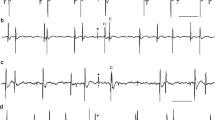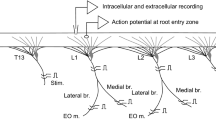Summary
The interneuronally mediated reflex actions evoked by electrical stimulation of group II muscle afferents in low spinal cats have been reinvestigated with intracellular recording from motoneurones to knee flexors and ankle extensors. The results of Eccles and Lundberg (1959) have been confirmed and extended. There was wide convergence from flexors and extensors of group II excitation to flexor and group II inhibition to extensor motoneurones. Some quantitative differences in the effect from the different nerves are described. Latency measurements suggest that the minimal linkage is disynaptic in the excitatory interneuronal pathways and trisynaptic in the inhibitory pathways. Disynaptic group II EPSPs were found in 14% of the ankle extensor motoneurones but were much more common in unanaesthetized high spinal cats (Wilson and Kato 1965). From these results and corresponding ones on flexors (Holmqvist and Lundberg 1961) it is postulated that secondary afferents in addition to the weak monosynaptic connexions (Kirkwood and Sears 1975) have disynaptic excitatory pathways and trisynaptic inhibitory pathways to both flexor and extensor motoneurones. It is proposed that the group II actions of the flexor reflex pattern characterizing the anaesthetized low spinal cat are due to suppression of the inhibitory pathway to flexor motoneurones and the excitatory pathway to extensor motoneurones. In some ankle extensor motoneurones the disynaptic group II EPSPs occurred in combination with IPSPs from the FRA (including group II and III muscle afferents). The possibility is considered that these group II EPSPs are mediated by an interneuronal group II pathway with little or no input from group III muscle afferents but probably from extramuscular receptors. In other ankle extensor motoneurones group II EPSPs were combined with EPSPs from group III muscle afferents, cutaneous afferents and joint afferents. It is postulated that these group II EPSPs are mediated by an interneuronal pathway from the FRA which also supply interneuronal pathways giving inhibition to extensor or/and flexor motoneurones and excitation to flexors as postulated by Eccles and Lundberg (1959) and Holmqvist and Lundberg (1961).
Similar content being viewed by others
Abbreviations
- Q:
-
Quadriceps
- PBSt:
-
posterior biceps and semitendinosus
- ABSm:
-
anterior biceps and semimembranosus
- G-S:
-
gastrocnemius and soleus
- FDHL:
-
flexor digitorum and hallucis longus
- Pl:
-
plantaris
- DP:
-
tibialis anterior and extensor digitorum longus
- EDB:
-
extensor digitorum brevis
- SPM or separately, Per br and Per 1:
-
peroneus longus, tertius and brevis together
- joint:
-
posterior nerve from knee joint
- Sur:
-
sural
- Saph:
-
saphenous
- SP:
-
skin division of superficial peroneal
References
Appelberg B, Johansson H, Kalistratov G (1977) The influence of group II muscle afferents and low threshold skin afferents on dynamic fusimotor neurones to the triceps surae of the cat. Brain Res 132: 153–158
Appelberg B, Hulliger M, Johansson H, Sojka P (1983) Actions on γ-motoneurones elicited by electrical stimulation of group II muscle afferent fibres in the hind limb of the cat. J Physiol (Lond) 335: 255–273
Baldissera F, Hultborn H, Illert M (1981) Integration in spinal neuronal systems. In: Brooks VB (ed) Handbook of physiology, Sect I. The nervous system, Vol II, Motor control. Am Physiol Soc, Bethesda, MD, pp 509–595
Boyd IA, Davey MR (1968) Composition of peripheral nerves. E & S Livingstone Ltd, Edinburgh and London
Bradley K, Eccles JC (1953) Analysis of the fast afferent impulses from thigh muscles. J Physiol (Lond) 122: 462–473
Brown AG (1981) Organization in the spinal cord. Springer, Berlin Heidelberg New York
Cangiano A, Lutzemberger L (1972) The action of selectively activated group II muscle afferent fibers on extensor motoneurons. Brain Res 41: 475–478
Eccles RM, Lundberg A (1959) Synaptic actions in motoneurones by afferents which may evoke the flexion reflex. Arch Ital Biol 97: 199–221
Ellaway PH, Murphy PR, Tripathi A (1982) Closely coupled excitation of γ-motoneurones by group III muscle afferents with low mechanical threshold in the cat. J Physiol (Lond) 331: 481–498
Fedina L, Hultborn H (1972) Facilitation from ipsilateral primary afferents of interneuronal transmission in the Ia inhibitory pathway to motoneurones. Acta Physiol Scand 86: 59–81
Fu TC, Schomburg ED (1974) Electrophysiological investigation of the projection of secondary muscle spindle afferents in the cat spinal cord. Acta Physiol Scand 91: 314–329
Fu TC, Santini M, Schomburg ED (1974) Characteristics and distribution of spinal focal synaptic potentials generated by group II muscle afferents. Acta Physiol Scand 91: 298–313
Holmqvist B, Lundberg A (1961) Differential supraspinal control of synaptic actions evoked by volleys in the flexion reflex afferents in alpha motoneurones. Acta Physiol Scand 54: Suppl 186
Hongo T, Kudo N, Yamashita M, Ishizuka N, Mannen H (1981) Transneuronal passage of intraaxonally injected horseradish peroxidase (HRP) from group Ib and II fibers into the secondary neurons in the dorsal horn of the cat spinal cord. Biomed Res 2: 722–727
Hongo T, Ishizuka N, Kudo N, Mannen H, Sasaki S, Yamashita M (1983) Intraspinal morphology of group II muscle spindle afferents. Abstract. Symp.: Reflex organization of the spinal cord and its descending control. Canberra, Australia
Houk JC, Rymer WZ (1981) Neural control of muscle length and tension. In: Brooks VB (ed) Handbook of physiology, Sect I. The nervous system, Vol II. Motor control. Am Physiol Soc, Bethesda, MD, pp 257–323
Hulliger M (1984) The mammalian muscle spindle and its central control. Rev Physiol Biochem Pharmacol 101: 1–110
Hunt CC (1953) Diameter and function of afferent fibres from muscles. Abstract. XIX Int Physiol Congress, Montreal
Hunt CC (1954) Relation of function to diameter in afferent fibres of muscle nerves. J Gen Physiol 38: 117–131
Kirkwood PA, Sears TA (1975) Monosynaptic excitation of motoneurones from muscle spindle secondary endings of intercostal and triceps surae muscles in the cat. J Physiol (Lond) 245: 64P-66P
Laporte Y, Bessou P (1959) Modification d'excitabilité de motoneurones homonymes provoqées par l'activation physiologique de fibres afférentes d'origine musculaire du groupe II. J Physiol (Paris) 51: 897–908
Lloyd DPC (1943) Neuron patterns controlling transmission of ipsilateral hind limb reflexes in cat. J Neurophysiol 6: 293–315
Lloyd DPC (1946) Integrative pattern of excitation and inhibition in two-neuron reflex arcs. J Neurophysiol 9: 439–444
Lundberg A (1959) Integrative significance of patterns of connections made by muscle afferents in the spinal cord. Symp XXI Int Physiol Congr, Buenos Aires, pp 1–5
Lundberg A, Voorhoeve P (1962) Effects from the pyramidal tract on spinal reflex arcs. Acta Physiol Scand 56: 201–219
Lundberg A, Malmgren K, Schomburg ED (1975a) Characteristics of the excitatory pathway from group II muscle afferents to alpha motoneurones. Brain Res 88: 538–542
Lundberg A, Malmgren K, Schomburg ED (1975b) Group II excitation in motoneurones and double sensory innervation of extensor digitorum brevis. Acta Physiol Scand 94: 398–400
Lundberg A, Malmgren K, Schomburg ED (1977) Comments on reflex actions evoked by electrical stimulation of group II muscle afferents. Brain Res 122: 551–555
Lundberg A, Malmgren K, Schomburg ED (1987a) Reflex path-ways from group II muscle afferents. 2. Functional characteristics of reflex pathways to α-motoneurones. Exp Brain Res 65: 282–293
Lundberg A, Malmgren K, Schomburg ED (1987b) Reflex path-ways from group II muscle afferents. 3. Secondary spindle afferents and the FRA; a new hypothesis. Exp Brain Res 65: 294–306
Lüscher H-R, Ruenzel P, Fetz E, Henneman E (1979) Postsynaptic population potentials recorded from ventral roots perfused with isotonic sucrose: connections of groups Ia and II spindle afferent fibers with large populations of motoneurons. J Neurophysiol 42: 1146–1164
Matthews PBC (1972) Mammalian muscle receptors and their central actions. Edward Arnold Publishers Ltd, London
Munson JB, Sypert GW, Zengel JE, Lofton SA, Fleshman JW (1982) Monosynaptic projections of individual spindle group II afferents to type-identified medial gastrocnemius motoneurons in the cat. J Neurophysiol 48: 1164–1174
Oscarsson O (1973) Functional organization of spinocerebellar paths. In: Iggo A (ed) Handbook of sensory physiology, Vol II. Somatosensory systems. Springer, Berlin Heidelberg New York, pp 339–380
Rymer WZ, Houk JC, Crago PE (1979) Mechanisms of the claspknife reflex studied in an animal model. Exp Brain Res 37: 93–113
Stauffer EK, Watt DGD, Taylor A, Reinking RM, Stuart DG (1976) Analysis of muscle receptor connections by spiketriggered averaging. 2. Spindle group II afferents. J Neurophysiol 39: 1393–1402
Wilson VJ, Kato M (1965) Excitation of extensor motoneurons by group II afferent fibers in ipsilateral muscle nerves. J Neurophysiol 28: 545–554
Author information
Authors and Affiliations
Additional information
This work was supported by the Swedish Medical Research Council (project no. 94)
Rights and permissions
About this article
Cite this article
Lundberg, A., Malmgren, K. & Schomburg, E.D. Reflex pathways from group II muscle afferents. Exp Brain Res 65, 271–281 (1987). https://doi.org/10.1007/BF00236299
Received:
Accepted:
Issue Date:
DOI: https://doi.org/10.1007/BF00236299




